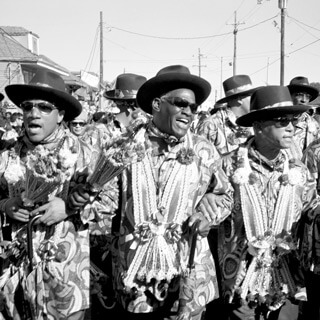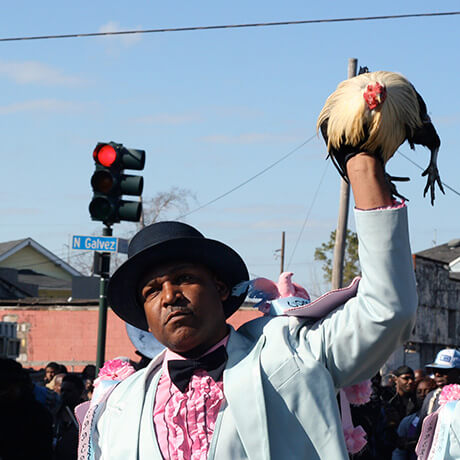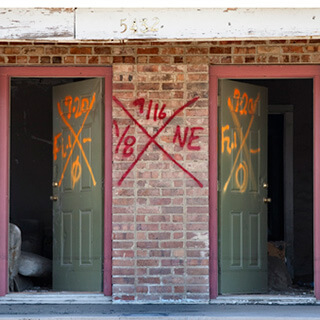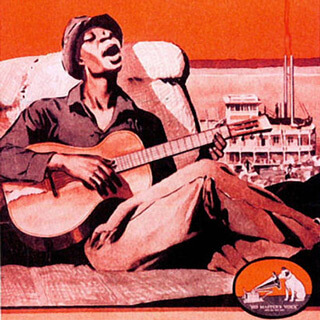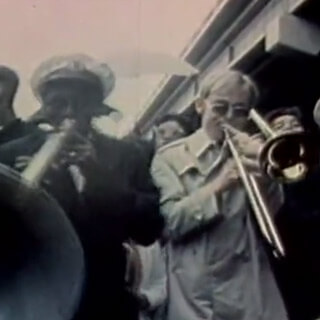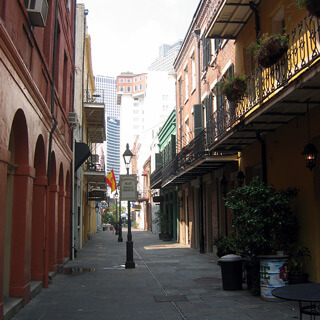Overview
Lydia Pelot-Hobbs reviews Matt Sakakeeny's Roll With It: Brass Bands in the Streets of New Orleans (Durham: Duke University Press, 2013). Artwork by Willie Birch.
Review
 |
| Willie Birch, Martin Luther King Day Parade, 2003. Acrylic and charcoal on paper, 72 x 96 inches. Courtesy of the artist and Arthur Roger Gallery. |
In Roll With It: Brass Bands in the Streets of New Orleans Matt Sakakeeny traces the celebrated and contested political and economic terrain where brass bands make music that defines the city. In Sakakeeny's detailed and nuanced ethnographic study, he reveals how brass bands "utilize voices and instruments as technologies for producing subjectivity, identity, and culture" (6). Accompanied by black and white drawings by New Orleans artist Willie Birch, Sakakeeny transports readers to the second line and beyond, to the debates surrounding the production of brass music today. Sakakeeny's ongoing relationships with New Orleans's cultural producers, including his conversations with Birch, allow him to provide texture and detail about the material realities faced by musicians. He emphasizes how musicians in bands such as Hot 8, Rebirth, and Soul Rebels continue to innovate brass music amid the systemic violence and racialized neoliberalism structuring everyday life.
 |
| Jazz funeral for K-Boo, a twenty-four year old murder victim, Tremé neighborhood, New Orleans, LA, February 19, 2011. Photograph by Derek Bridges. |
Mobility is a principal point of departure for Sakakeeny's understanding of brass bands within contemporary New Orleans. For any parade, the band must move the crowd. The participatory nature of second lines "facilitates relations between people, providing a sense of place in which the social is enmeshed with the political and the present is entangled in the past" (24). Claiming public space via black cultural traditions that converge in second lines and jazz funerals, participants enact agency and solidarity through bodies, voices, and instruments.
Mobility is also central to thousands of black New Orleanians who have long fought forced removal from gentrifying neighborhoods. Sakakeeny situates contemporary conditions of displacement within a longer urban history that includes the birth of New Orleans black music in Congo Square where slaves congregated to perform, dance, and socialize during the eras of French and Spanish colonialism. The Tremé developed around Congo Square as one of the first neighborhoods of free people of color in the United States in the late eighteenth century.1For more on the history of the Tremé see: Ned Sublette, The World That Made New Orleans: From Spanish Silver to Congo Square (Chicago: Lawrence Hill Books, 2008); Michael Eugene Crutcher, Tremé: Race and Place in a New Orleans Neighborhood (Athens: University of Georgia Press, 2010). While Sakakeeny argues it would be simplistic and essentialist to draw a direct line between the music of Congo Square and the brass bands of today, it would be equally problematic to ignore "the ongoing persistence and dynamic vitality of outdoor festival traditions" among black New Orleanians as an affirmation of life against the history of bondage and violence (19).
 |
| Intersection of St. Bernard Avenue and I-10 in Tremé, New Orleans, Louisiana, December 31, 2008. Photograph by Emma Lirette. |
Sakakeeny charts how projects such as the construction of Interstate 10 through the central business corridor of the Tremé, and the demolition of multiple blocks to build a cultural center in the 1960s kicked off a "racialized remapping" of the neighborhood (28). In the 1980s new residents straddling color and class lines were drawn to the neighborhood's cultural legacy and began to buy houses. In founding the Historic Faubourg Tremé Association these newcomers hoped to tackle, according to their mission statement "blight, crime, and grime" (29). Sakakeeny recounts how Association members promoted laws and zoning practices that shut down bars and blocked live music, leading to fewer venues for brass bands and other New Orleans musicians. The author identifies ripple effects caused by these changes, such as the increased policing of second lines and jazz funerals, two outcomes that Sakakeeny interprets as both result and strategy of the Tremé's gentrification.
To reveal the tensions inherent in the Tremé's development, Roll With It offers the example of Kerwin James of Rebirth Brass Band, who suffered a stroke and fell into a coma after Hurricane Katrina. Following his passing in 2007, fellow musicians played an impromptu procession in advance of the official jazz funeral. "At 8 p.m., in response to a noise complaint," Sakakeeny writes, "multiple police cars—lights ablaze, sirens drowning out the music—descended on the procession of about a hundred people, and officers arrested Derrick Tabb and trombonist Glen David Andrews as they were playing the traditional spiritual 'I'll Fly Away.' The charges were Disturbing the Peace and Parading without a Permit" (56).2Ironically, Kerwin James was best known for his arrangement of "Who Dat Called the Police?" a now classic brass band song to play when cops attempt to break up a secondline or jazz funeral.
In an all-too-classic story of gentrification, most brass band musicians can no longer afford to live in the Tremé, and newer residents' cultural norms now translate into the policing of what were previously everyday activities and practices—such as playing music in the streets. Even if new residents were initially drawn to the neighborhood for its traditions, they are not necessarily interested in the living musical and cultural practices. Such "quality of life" policing and noise regulations have spread throughout New Orleans, restricting and often silencing the music for which the city is known.3Contestations around live music have become commonplace across New Orleans's neighborhoods in recent years. Policing these regulations on music has been uneven with some bars gaining music permits, others being required to shut down, and yet other venues choosing to forego live music to avoid potential complaints. See Jan V. Ramsey, "Let's Just Shut Frenchmen Street Down - Offbeat Magazine," Offbeat Magazine Lets Just Shut Frenchmen Street Down Comments, March 14, 2012, accessed December 19, 2014, http://www.offbeat.com/2012/03/14/lets-just-shut-frenchmen-street-down; Michael Welch, "Music Rights: An Educated Opinion on New Orleans' Noise Ordinances (AntiGravity. Nov 2011)." New Orleans the Underground Guide, May 13, 2012, accessed December 19, 2014, http://michaelpatrickwelch.org/2012/05/13/music-rights-an-educated-opinion-on-new-orleans-noise-ordinances-antigravity-nov-2011/; Alex Woodward, "Autopsy of the Noise Ordinance," Gambit, May 13, 2014, accessed December 19, 2014, http://www.bestofneworleans.com/gambit/autopsy-of-the-noise-ordinance/Content?oid=2433600; Alex Woodward, "Mimi's in the Marigny Cancels Live Music; Buffa's Faces 'noise' Lawsuit," Gambit, July 3, 2014, accessed December 19, 2014, http://www.bestofneworleans.com/blogofneworleans/archives/2014/07/03/mimis-in-the-marigny-cancels-live-music-buffas-faces-noise-lawsuit. However, musicians have not ignored this shifting event as is evident in the formation of the Music and Culture Coalition of New Orleans by local musicians to combat the crackdown against local musicians. "Who We Are," Music and Culture Coalition of New Orleans, accessed September 24, 2014, http://maccno.com/sample-page/who-we-are/.
Sakakeeny teases out a similar contradiction in the role of musicians as workers within the cultural economy of New Orleans where music has long provided a potential means of social mobility. In sketching the experiences of brass band musicians, he illuminates how "the precarity of insecure and flexible labor that is so often linked to the rise of the neoliberal state has been a state of perpetuity for black musicians" (77). Sakakeeny describes the limited opportunities available to black men in New Orleans, particularly in the context of hyper-incarceration—one in fourteen black males in the metro region today are imprisoned.4Cindy Chang, "Louisiana Is the World's Prison Capital," NOLA.com, May 12, 2012, accessed September 24, 2014, http://www.nola.com/crime/index.ssf/2012/05/louisiana_is_the_worlds_prison.html. By presenting life histories of several brass band musicians, Roll With It illustrates that the conditions that allow some to succeed and others to continuously struggle must be understood within the current context of deindustrialization and economic restructuring. In the late twentieth century, New Orleans became a service-oriented tourist economy with culture, including music, at its center (80).5See also Kevin Fox Gotham, "Tourism Gentrification: The Case of New Orleans' Vieux Carre (French Quarter)," Urban Studies 42, no. 7 (2005); Jonathan Mark Souther, New Orleans on Parade: Tourism and the Transformation of the Crescent City (Baton Rouge: Louisiana State University Press, 2006). This has not translated to material gains for local musicians, but rather to their devaluation as "service workers" (83). The result is a dynamic where "culture begins with cultural workers who originate content, but cultural economics ends with those same workers, the last to receive any financial return. There is no cultural economy without their labor, but much of the money they generate accumulates elsewhere" (86).
This dynamic has intensified in the years following Hurricane Katrina, as city leaders' mobilization of culture and music in the rebuilding process has not translated to increased valuation of musicians' labor. Sakakeeny writes that although the annual Jazz and Heritage Festival markets itself through New Orleans-based music and cultural practices, the festival frequently offers meager salaries to local artists while generously compensating national musicians. Jazz Fest featured Rebirth Brass Band on their festival posters in 2007, trading on the connection between the brass band's name and the city's reconstruction. Despite the highly visible role of the band in promoting that year's festival, Rebirth was initially offered $3,000, significantly less than the $75,000 paid to national headlining acts. Rebirth was able to re-negotiate their compensation, but most New Orleans musicians lacked their clout (100). Roll With It argues that although Jazz Fest has been marketed as a way for tourists to support local musicians post-Katrina, its substantial profits inadequately support New Orleans–based musicians. Sakakeeny further emphasizes the complicated economic position for brass musicians within this tourist economy, acknowledging that the most secure employment for musicians today can be found at Harrah's Casino on the edge of the French Quarter. Roll With It leaves us wondering how musicians can meaningfully perform and attain financial security.
Sakakeeny also delves into the internal debates among brass bands regarding "tradition." While members of the "post-Civil Rights" or "hip-hop" generation have brought new fashions, sites of performance, and arrangements of contemporary music to brass bands, these innovations have disturbed some members of an older generation who call for the preservation of traditions that include second lines and jazz funerals within a racial politics of respectability.Roll With It embraces tradition—for example, the creation of the Black Men of Labor Social Aid and Pleasure Club as an explicitly traditionalist organization—and change, acknowledging that brass bands are inherently dynamic and evolving. For example, Sakakeeny discusses how brass bands have reshaped themselves in response to the popularity of hip-hop among black New Orleanians.
New Orleans is frequently rendered as exceptional in the US through two intertwined narratives.6Such exceptionalist renderings go as far back to the writings of George Washington Cable and Lafcadio Hearn and appear as recently as David Simon's HBO show Treme. One frames the city as a place of extraordinary disinvestment, corruption, and violence. The other positions New Orleans as home to incomparable cultural traditions and practices that must not be lost. At the outset of Roll With It, Sakakeeny writes that his original investment in New Orleans exceptionalism has become more nuanced as he has recognized that the recent history of the city aligns with the experience of US urban disinvestment and racialized neoliberalism more generally. Yet, at moments, Sakakeeny also reaffirms that New Orleans is an exceptional place as articulated through its expressive cultures, an articulation that justifies the saving of the city in a post-Katrina world. Are places only worth saving if they are understood as unique and special? It is the very exceptionalist logic that values New Orleans primarily for its music and culture that has fostered the proliferation of a tourist economy that has, in turn, intensified the economic precarity of a majority of the city's residents, including black musicians.
 |
| "Black Men of Labor Lead Doc Paulin's Jazz Funeral," New Orleans, Louisiana, November 25, 2007. Photograph by Derek Bridges. |
Roll With It is a welcome contribution to our understanding of New Orleans, cultural production, and the politics of place. Sakakeeny does a remarkable job capturing the movement of brass bands as they continue to weave through the varied powers of the city, reshaping traditions as New Orleans remakes itself. By following the production of brass music, second lines, and jazz funerals, Sakakeeny offers a necessary glimpse into broader contestations and negotiations over New Orleans's past, present, and possible futures. 
Acknowledgments
Thanks to Eric Lott and Byron Asher for their feedback and suggestions on this review. Thanks to Willie Birch and the Arthur Roger Gallery for allowing us to reprint Martin Luther King Day Parade, and to Derek Bridges and Emma Lirette for permission to include their photographs of New Orleans.
About the Author
Lydia Pelot-Hobbs is a doctoral candidate in geography and is pursuing a certificate in American studies at the Graduate Center of the City University of New York. Her dissertation tracks the dialectical relationship between the formation and contestation of the Louisiana carceral state from the 1970s to the present. Pelot-Hobbs's research is situated within scholarship on prisons, racial capitalism, the US South, and social movements. A guiding impulse of her work is to produce research that is grounded in and relevant to grassroots organizing for collective liberation. Her writing has been published in a broad range of academic and activist venues including Monthly Review Online, Left Turn Magazine, The Abolitionist, Souls: A Critical Journal of Black Politics, Culture, and Society, and in the anthology Unfathomable City: A New Orleans Atlas (University of California Press, 2013).
Recommended Resources
Text
Campanella, Richard. "Gentrification and its Discontents: Notes from New Orleans." New Geography, March 1, 2013. http://www.newgeography.com/content/003526-gentrification-and-its-discontents-notes-new-orleans.
Dyson, Michael Eric. Come Hell or High Water: Hurricane Katrina and the Color of Disaster. New York: Basic Civitas, 2006.
Regis, Helen A., and Shana Walton. "Producing the Folk at the New Orleans Jazz and Heritage Festival." Journal of American Folklore 121, no. 482 (Fall 2008): 400–440.
Solnit, Rebecca and Rebecca Snedeker. Unfathomable City: A New Orleans Atlas. Oakland: University of California Press, 2013.
Starr, S. Frederick. Inventing New Orleans: Writings of Lafcadio Hearn. Jackson: University Press of Mississippi, 2001.
Web
Neighborhood Story Project. University of New Orleans. http://www.neighborhoodstoryproject.org/.
New Orleans Jazz Celebration. http://www.nojc.org.
Video
Logsdon, Dawn and Lolis Eric Elie. Faubourg Treme: The Untold Story of Black New Orleans. http://www.tremedoc.com/home/.
Similar Publications
| 1. | For more on the history of the Tremé see: Ned Sublette, The World That Made New Orleans: From Spanish Silver to Congo Square (Chicago: Lawrence Hill Books, 2008); Michael Eugene Crutcher, Tremé: Race and Place in a New Orleans Neighborhood (Athens: University of Georgia Press, 2010). |
|---|---|
| 2. | Ironically, Kerwin James was best known for his arrangement of "Who Dat Called the Police?" a now classic brass band song to play when cops attempt to break up a secondline or jazz funeral. |
| 3. | Contestations around live music have become commonplace across New Orleans's neighborhoods in recent years. Policing these regulations on music has been uneven with some bars gaining music permits, others being required to shut down, and yet other venues choosing to forego live music to avoid potential complaints. See Jan V. Ramsey, "Let's Just Shut Frenchmen Street Down - Offbeat Magazine," Offbeat Magazine Lets Just Shut Frenchmen Street Down Comments, March 14, 2012, accessed December 19, 2014, http://www.offbeat.com/2012/03/14/lets-just-shut-frenchmen-street-down; Michael Welch, "Music Rights: An Educated Opinion on New Orleans' Noise Ordinances (AntiGravity. Nov 2011)." New Orleans the Underground Guide, May 13, 2012, accessed December 19, 2014, http://michaelpatrickwelch.org/2012/05/13/music-rights-an-educated-opinion-on-new-orleans-noise-ordinances-antigravity-nov-2011/; Alex Woodward, "Autopsy of the Noise Ordinance," Gambit, May 13, 2014, accessed December 19, 2014, http://www.bestofneworleans.com/gambit/autopsy-of-the-noise-ordinance/Content?oid=2433600; Alex Woodward, "Mimi's in the Marigny Cancels Live Music; Buffa's Faces 'noise' Lawsuit," Gambit, July 3, 2014, accessed December 19, 2014, http://www.bestofneworleans.com/blogofneworleans/archives/2014/07/03/mimis-in-the-marigny-cancels-live-music-buffas-faces-noise-lawsuit. However, musicians have not ignored this shifting event as is evident in the formation of the Music and Culture Coalition of New Orleans by local musicians to combat the crackdown against local musicians. "Who We Are," Music and Culture Coalition of New Orleans, accessed September 24, 2014, http://maccno.com/sample-page/who-we-are/. |
| 4. | Cindy Chang, "Louisiana Is the World's Prison Capital," NOLA.com, May 12, 2012, accessed September 24, 2014, http://www.nola.com/crime/index.ssf/2012/05/louisiana_is_the_worlds_prison.html. |
| 5. | See also Kevin Fox Gotham, "Tourism Gentrification: The Case of New Orleans' Vieux Carre (French Quarter)," Urban Studies 42, no. 7 (2005); Jonathan Mark Souther, New Orleans on Parade: Tourism and the Transformation of the Crescent City (Baton Rouge: Louisiana State University Press, 2006). |
| 6. | Such exceptionalist renderings go as far back to the writings of George Washington Cable and Lafcadio Hearn and appear as recently as David Simon's HBO show Treme. |
